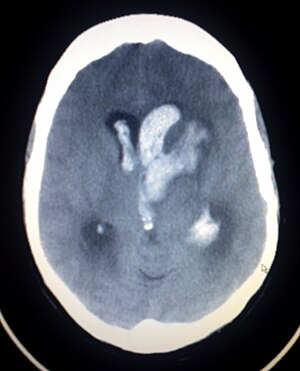Intracranial hemorrhage
| Intracranial hemorrhage | |
|---|---|
 |
|
| Axial CT scan of a spontaneous intracranial hemorrhage | |
| Classification and external resources | |
| Specialty | emergency medicine |
| ICD-10 | I60.0-I62, S06 |
| ICD-9-CM | 430-432, 850-854 |
| DiseasesDB | 6870 |
| eMedicine | neuro/177 |
| MeSH | D020300 |
Intracranial hemorrhage (ICH), also known as intracranial bleed is bleeding within the skull. It includes intracerebral bleeds (intraventricular bleeds and intraparenchymal bleeds), subarachnoid bleeds, epidural bleeds, and subdural bleeds.
Intracerebral bleeding affects 2.5 per 10,000 people each year.
Intracranial hemorrhage is a serious medical emergency because the buildup of blood within the skull can lead to increases in intracranial pressure, which can crush delicate brain tissue or limit its blood supply. Severe increases in intracranial pressure (ICP) can cause brain herniation, in which parts of the brain are squeezed past structures in the skull.
Intracranial bleeding occurs when a blood vessel within the skull is ruptured or leaks. It can result from physical trauma (as occurs in head injury) or nontraumatic causes (as occurs in hemorrhagic stroke) such as a ruptured aneurysm. Anticoagulant therapy, as well as disorders with blood clotting can heighten the risk that an intracranial hemorrhage will occur.
CT scan (computed tomography) is the definitive tool for accurate diagnosis of an intracranial hemorrhage. In difficult cases, a 3T-MRI scan can also be used.
...
Wikipedia
